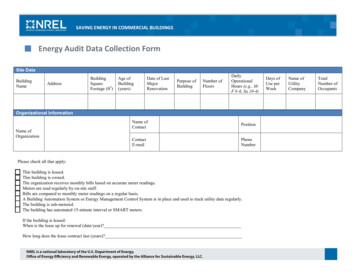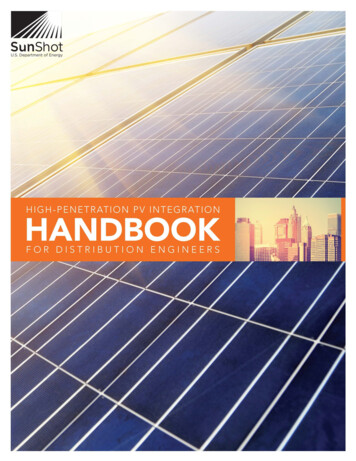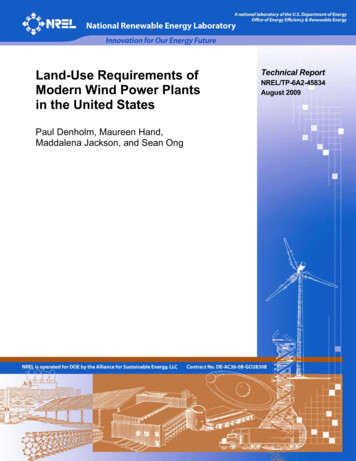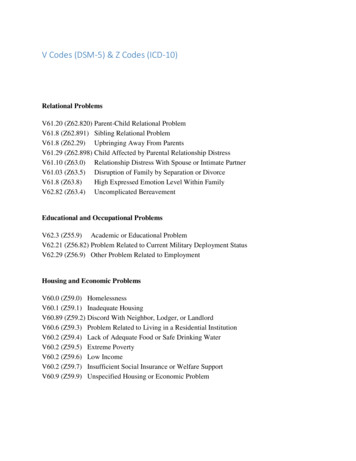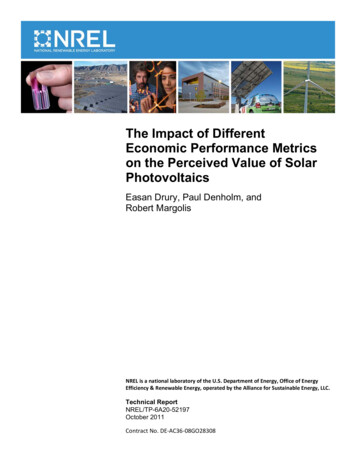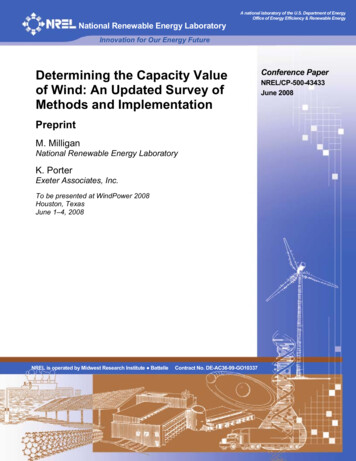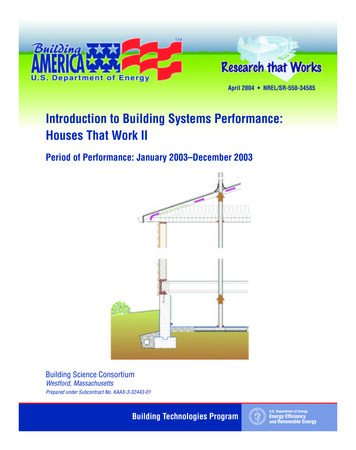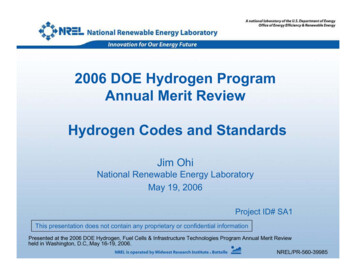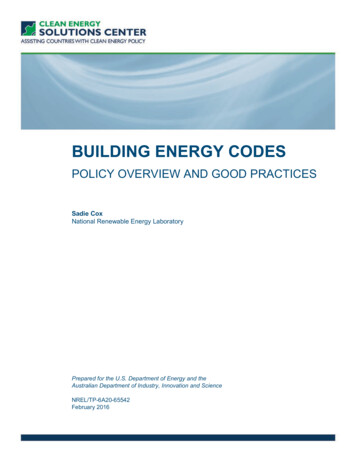
Transcription
BUILDING ENERGY CODESPOLICY OVERVIEW AND GOOD PRACTICESSadie CoxNational Renewable Energy LaboratoryPrepared for the U.S. Department of Energy and theAustralian Department of Industry, Innovation and ScienceNREL/TP-6A20-65542February 2016
BUILDING ENERGY CODESPOLICY OVERVIEW AND GOOD PRACTICESSadie CoxNational Renewable Energy LaboratoryPrepared for the U.S. Department of Energy and theAustralian Department of Industry, Innovation and ScienceNREL/TP-6A20-65542February 2016
NOTICEThis manuscript has been authored by employees of the Alliance for Sustainable Energy, LLC (“Alliance”)under Contract No. DE-AC36-08GO28308 with the U.S. Department of Energy (“DOE”).This report was prepared as an account of work sponsored by an agency of the United Statesgovernment. Neither the United States government nor any agency thereof, nor any of their employees,makes any warranty, express or implied, or assumes any legal liability or responsibility for the accuracy,completeness, or usefulness of any information, apparatus, product, or process disclosed, or representsthat its use would not infringe privately owned rights. Reference herein to any specific commercialproduct, process, or service by trade name, trademark, manufacturer, or otherwise does not necessarilyconstitute or imply its endorsement, recommendation, or favoring by the United States government or anyagency thereof. The views and opinions of authors expressed herein do not necessarily state or reflectthose of the United States government or any agency thereof.iii
AcknowledgmentsThe author would like to thank Ron Benioff, Victoria Healey, Terri Walters, Jaquelin Cochran,Jeffrey Logan, and David Mooney of the National Renewable Energy Laboratory, and Ian Lloyd andJonah Steinbuck of the U.S. Department of Energy for their review and insights. All information andany omissions are the responsibility of the author, not the reviewers.iv
Table of ContentsIntroduction . 1Policy Design and Good Practices. 4Use model building codes to inform interlinked national and subnational building code efforts. 4Engage stakeholders throughout the process to secure support for adoption and implementation. 4Conduct robust analysis to assess costs and benefits, inform code design, and provide afoundation for policy evaluation . 5Develop a comprehensive and long term building code strategy, increasing in stringency overtime . 6Build strong compliance infrastructure to ensure effective building code enforcement. 7Educate building sector stakeholders and code officials on the importance of building energycodes to increase support for compliance and recognize strong performance . 8Rigorously evaluate energy codes to understand strengths and weaknesses and support improvedpolicy design and implementation over time. 9Provide ongoing capacity building, training and resources to sector stakeholders to build supportfor code compliance and ensure effective design and implementation . 9Capture benefits of interlinked policies through designing a strong policy framework . 10References. 12Appendix. Additional Support and Resources . 14v
List of FiguresFigure 1. Building energy codes in place for new residential buildings . 2Figure 2. Barriers to energy efficiency in the building sector . 3Figure 3. Percentage of potential energy savings of key energy efficiency measures across buildingsectors based on sensitivity analysis . 6Figure 4. Building energy code compliance cycle . 7Figure 5. Example building sector clean energy policy package . 11List of Text BoxesText Box 1. What is a Building Energy Code? . 1Text Box 2. Industry Stakeholder Engagement and Leadership Prompts Strong Support for BuildingEnergy Codes . 4Text Box 3. Robust Analysis Supports Indonesia’s Building Energy Codes . 6Text Box 4. China’s Multi-Tiered Approach Supports Building Energy Code Enforcement andCompliance . 8Text Box 5. Standard Bearers Award Recognizes and Rewards Innovative and Effective BuildingCode Action . 9Text Box 6. Albania Supports Improvement of Implementation and Enforcement of Building EnergyCodes . 10Text Box 7. Building Energy Codes Portal Supports Global Knowledge Sharing . 11vi
IntroductionGlobally, 32% of total final energyconsumption 1 is attributed to thebuilding sector (IEA 2015). To supportreduction of energy consumption in thebuilding sector, energy codes setminimum energy efficiency standardsfor building technologies and designelements that may include: the buildingenvelope; heating, ventilation, and airconditioning (HVAC) systems; lighting;and service water heating systems(Rosenberg et al. 2015). With effectiveimplementation, building energy codescan support energy cost savings andcomplementary benefits associated withelectricity reliability, air qualityimprovement, greenhouse gas emissionreduction, increased comfort, andeconomic and social development. Thispolicy brief seeks to supportpolicymakers and implementers indesigning effective building codeprograms.Text Box 1. What is a Building Energy Code?Building energy codes are regulatory instrumentsthat specify minimum energy efficiency standards forthe residential and commercial building sectors.Building energy codes commonly mandate certainenergy efficiency characteristics for buildingtechnologies. As another approach, outcome-basedbuilding energy codes are aligned with technologyperformance and provide target energy use levels fora building as a whole. Building codes can bemandatory or voluntary and are often complementedby other energy efficiency building incentives.Building technologies and design elements that canbe included in a building code are: the buildingenvelope; heating, ventilation, and air conditioning(HVAC) systems; lighting; and service water heatingsystems.Sources: IEA 2013; VanGeem and Colker 2014; EPA 2015;Rosenberg et al. 2015; IPEEC 2015; EERE 2013As of 2015, approximately 40 national governments and many state and local jurisdictions around theworld had building energy codes in place (IEA 2015; Clean Energy Solutions Center 2015; EPA2015). Figure 1 presents countries that had energy codes in place for new residential buildings in2015. Notably, a number of countries in Latin America, Africa, the Middle East, and Southeast Asiahave not yet adopted energy codes for new residential buildings. Even fewer countries have adoptedbuilding energy codes for existing residential buildings. Similar geographic trends exist in thecommercial sector.“Final energy consumption is the total energy consumed by end users, such as households, industry and agriculture. It isthe energy which reaches the final consumer's door and excludes that which is used by the energy sector itself” (Eurostat2012).11
Figure 1. Building energy codes in place for new residential buildingsSource: IEA 2014Building codes seek to address common barriers to energy efficient building design. In manymarkets, builders have little financial incentive to build energy efficient buildings because thesubsequent owners or tenants will pay the energy bills and reap any benefits from lower costs. This isreferred to as a “split incentive.” In some cases, certain energy efficient technologies may result inincreased initial capital costs for the builder, which take time to recover through energy cost savings.Further, homebuyers, with limited budgets, often opt for cosmetic or size-related home upgradesinstead of energy efficiency, which hinders the uptake of energy efficiency technologies inresidential buildings (EPA 2015). Figure 2 outlines these and other common barriers to energyefficiency in the building sector.2
Figure 2. Barriers to energy efficiency in the building sectorSource: BPIE 2011Robust building energy codes and implementation processes, coupled with other key policies andincentives, can address key barriers to deployment of energy-efficient technologies in the buildingsector (IEA 2013; EPA 2015).3
Policy Design and Good PracticesKey design elements and good practices, drawn from global experience and lessons, can supporteffective building code development and implementation, tailored to meet country-specific goals.Use model building codes to inform interlinked national and subnational buildingcode effortsModel building energy codes developed by international institutions such as the International CodeCouncil (ICC) can feed into national-level model codes often developed by Ministries of Energy withguidance, input, and support from technical institutions and other stakeholders. Model codedevelopment and revision at the national level often takes place over a multi-year period to ensurerobust analysis and stakeholder input. Strong model codes developed at the national and/orinternational level can be used as a foundation for subnational codes tailored to local circumstances.Local authorities can also consider adoption of simplified codes developed by internationalinstitutions such as ICC or develop their own simplified codes that integrate easily understandabletext and high-level tables summarizing key points. Local building codes are often adopted throughregulatory mechanisms or legislation (EPA 2015; IEA 2014; IPEEC 2015).Engage stakeholdersthroughout the process tosecure support foradoption andimplementationVarious stakeholders within thegovernment, utilities, privatesector, and technical institutionsplay key roles in ensuringeffective design andimplementation of buildingenergy codes.Governments provide theessential foundation for buildingcode action. At the highest level,and as described above, nationalgovernments can support effectivebuilding code programs bydeveloping model building energycodes that inform subnationalefforts. In addition, energyefficiency and building energycode champions within thenational government can play animportant role in drawingattention to the benefits andcritical nature of building codeText Box 2. Industry Stakeholder Engagement andLeadership Prompts Strong Support for BuildingEnergy CodesThe Texas Energy Code Compliance Collaborative(TECCC), which comprises industry stakeholders, providesan innovative approach to support local governments inimplementation of building energy codes through training,education, and outreach campaigns. In partnership with theSouth-central Partnership for Energy Efficiency as aResource (SPEER), TECCC works with local Energy CodeAmbassadors to provide training on the ground based onlocal needs and challenges and to support peer to peerlearning across municipalities. SPEER and the TECCC arefunded by various public and private sources.TECCC and SPEER are critical assets in supportingunderstanding and acceptance of building codes tofacilitate effective implementation at the local level. Basedon innovative engagement and education of privatebuilding sector leaders, Texas builders have come tostrongly support code implementation and enforcement.For example, building sector leaders have noted theirrecognition of the critical need to penalize companies thatproduce low quality materials and buildings that can harmthe industry as a whole.Sources: Herbert 2015; EPA 20154
implementation and enforcement (GBPN 2015; Clean Energy Solutions Center 2015). Subnationalgovernments are at the front line of building code implementation and are crucial in tailoring codesto local circumstances, ensuring strong code enforcement, and catalyzing support at the local level.Utilities can also support local building code implementation by including energy codes in integratedresource plans, contributing to analytical efforts to develop baselines and assess energy savings andother impacts, leading efforts to assess links with current energy efficiency programs, and supportingtargeted outreach and education programs.Engaging builders, owners, and other building industry actors involved with building managementand development on the ground is also important to ensure support of code requirements andcompliance preparedness (IEA 2014; EPA 2015; Levine et al. 2012). Text Box 2 presents successfulefforts in Texas to engage building industry stakeholders with code implementation. In addition,technical institutions and non-governmental organizations focused on building sector energyanalysis, outreach, and education often play key roles in supporting code development andimplementation at the national and local levels.Overall, creation of an inclusive stakeholder process that includes regular and ongoing engagementof the various actors described above can support provision of input and feedback on analysis anddraft codes from key actors, early identification of potential challenges, and broader acceptance tosupport successful code adoption, implementation, and enforcement (EPA 2015; IEA 2014; Levine etal. 2012).Conduct robust analysis to assess costs and benefits, inform code design, andprovide a foundation for policy evaluationAs a first analytical step, it is important to develop a baseline that accurately reflects current buildingenergy usage and other characteristics of the building market. Potential impacts of building energycodes can then be assessed in relation to this baseline. In particular, cost-benefit analysis can assessbuilding energy and cost savings, greenhouse gas emission and other air pollution impacts, andimpacts related to reliability of the power system, as well as construction and other administrativecosts to implement the codes. Costs and benefits can then be presented to stakeholders and comparedto inform development of the building codes. Identifying potential building code benefits in advanceof adoption can broaden stakeholder support and provide a strong foundation for ongoing analysis ofbenefits. In addition to assessing costs and benefits, market analysis is also critical to ensureavailability of products and suppliers to implement code requirements (EPA 2015). Finally, and veryimportantly, analysis of model codes and good practices in other countries and jurisdictions can alsoinform adaptation of effective codes to a specific area and context. Many high quality building codeshave been developed globally, providing countries and jurisdictions with excellent models andresources to support new building code programs (Clean Energy Solutions Center 2015). Text Box 3highlights Indonesia’s analytical approach to support achievement of national level energy savingstargets for new buildings (IBE 2011).5
Text Box 3. Robust Analysis Supports Indonesia’s Building Energy CodesTo support design of building energy codes and achievement of building energy targets acrosssectors, the government of Indonesia assessed energy savings of various energy efficiencymeasures in Jakarta’s building sector. As presented below, sensitivity analysis found that easilyimplementable measures could allow for energy savings of 30%–40% in new buildings inJakarta. Implementing these measures through building codes may support Indonesia inmeeting a high level target of 30% average energy savings in new buildings.Figure 3. Percentage of potential energy savings of key energy efficiency measuresacross building sectors based on sensitivity analysisDevelop a comprehensive and long term building code strategy, increasing instringency over timeLeveraging the analysis and stakeholder engagement described above, a plan of action can bedeveloped to support building code implementation. Clearly articulated high level objectives andquantitative targets for the short, medium, and long term can provide framing for the strategy inrelation to energy savings and other benefits such as air quality improvements. Effective targets oftenincrease over time as building codes are more widely implemented and/or codes become morestringent. In some cases, countries may choose to first develop a plan for implementation in a singlesector or for certain buildings (e.g., larger buildings) so they can test the code and learn from theexperience. Countries may also begin by adopting building codes for new buildings becauseimplementing energy efficiency technologies during construction of a building is often considerablyless costly than retrofitting an existing inefficient building. However, while countries may begin witha more limited scope of building code implementation, it is important to have a longer term roadmapfor implementation across the full building sector. As elaborated below, effective strategies6
encompass robust plans to implement, enforce, monitor, evaluate, and improve building codes overtime (Rosenberg et al. 2015; IPEEC 2015).Build strong compliance infrastructure to ensure effective building codeenforcementCompliance and enforcement of building energy codes is a key challenge, even in jurisdictions withadvanced building code processes. Local governments are often the most critical actors in supportingeffective compliance and building code enforcement (DOE 2015; EPA 2015; Levine et al. 2012;Clean Energy Solutions Center 2015). Based on global experience and as presented in Figure 4, theInternational Energy Agency put forth a compliance cycle that includes key inspections and otheractivities to support various stages of building code implementation and enforcement. Variousapproaches can be used to fund compliance. In many cases, builders may be required to covercompliance inspection costs through fees, while local and national governments may fund otherenforcement activities, such as additional random periodic inspections.Figure 4. Building energy code compliance cycleSource: IEA 2014Accredited independent institutions are often designated to oversee compliance and inspections andensure enforcement of building energy codes. Compliance data at the local level can feed into welldesigned and robust databases linked at the national level to support broader compliance analysis. Inaddition, the national government can put forth consistent methodologies for data analysis of localcompliance that can support efficient compliance analysis at the national level. As described below,compliance analysis is critical in evaluating building code programs and to inform revisions andimprovements. Openly communicating compliance trends to the public is also important and canallow public feedback to support improved processes in the future. For non-compliance, governmentscan consider fines, permit refusal, and other penalties (IEA 2014; Levine et al. 2012). Text Box 4presents a brief case study on China’s multi-tiered approach to support building code compliance.7
It is critical to have sufficient budget,staff, and analytical resources tosupport code implementation. At thelocal level, there is often a need todevote resources to training governmentstaff and/or independent institutions tosupport compliance and enforcement. Inaddition, software tools and buildingmaterial libraries are important to assesspotential building material trade-offsand/or to perform whole buildingsimulations. Various software tools areavailable to support complianceprocesses and can be chosen based onunique code features and localconsiderations (IEA 2014; EPA 2015;Levine et al. 2012).Text Box 4. China’s Multi-Tiered ApproachSupports Building Energy Code Enforcement andComplianceUnder the Code of Acceptance, China implemented astrong approach to enforce building energy codes thatinvolves compliance checks during various stages ofconstruction and engages multiple actors to support theprocess. Key stages and stakeholders are outlined below. Certified inspection companies, hired by developers,analyze building architectural plans to ensurecompliance. Local quality supervision agency reviews compliancereport from the inspection company. Local construction administration agency provides abuilding license following positive compliance reportreview. Certified engineering inspection companies, hired by theEducate building sectordeveloper, perform building inspections throughout thestakeholders and code officialsconstruction process.on the importance of building Local quality supervision agency also performsenergy codes to increasecompliance checks during the building process.support for compliance and Building projects may also be inspected through randomrecognize strong performanceannual inspections conducted through the Ministry ofBuilding energy code provisions areHousing. If a building fails the inspection, the issues canoften viewed as less critical than otherbe corrected within 30 days or the developer is fined.components of the building code (e.g., If buildings pass all compliance checks described above,those related to structural integrity andthe local construction agency issues occupancy permits.safety), which presents one of the mostSource: IEA 2014significant barriers to building energycode enforcement and compliance. Thiskey challenge often leads to inadequate allocation of resources and time for building codeenforcement. To address this issue, policymakers, in partnership with industry leaders, can designtargeted education and outreach programs for various building sector stakeholders and code officialsto communicate the critical nature and benefits of building energy efficiency (e.g., energy savings,electricity system reliability, improved indoor air quality). In addition, and as presented above, highlevel champions within the public and private sectors can be instrumental in supporting suchoutreach campaigns and creating a cultural shift to support building energy efficiency. Recognitionprograms can also be put in place to incentivize and build support for compliance. These programscan reward code officials and builders actively engaged in effective code compliance andenforcement (DOE 2015; Solutions Center 2015). Text Box 5 describes an innovative award programto incentivize effective building code implementation through dedicated action.8
Rigorously evaluate energy codes to understand strengths and weaknesses andsupport improved policy design and implementation over timeBuilding on compliance data,policymakers at the local and nationalText Box 5. Standard Bearers Award Recognizesand Rewards Innovative and Effective Buildinglevel can assess the effectiveness ofCode Actionbuilding energy codes to support futureimprovements. In addition to overallThe U.S. Standard Bearers Award provides nationalcompliance levels, policymakers may berecognition to building code stakeholders supportingbuilding energy code compliance through innovative andinterested in assessing energy savings,dedicated action. The award is open to governments andgrid reliability improvements, emissionprivate sector leaders improving building energy codereductions, and other developmentcompliance. The award inherently recognizes that manybenefits such as job creation. Outputs ofbuilding code implementers are working with constrainedthe analysis can be compared with targetsbudgets and in institutions that may not be fully supportiveand goals, as well as pre-implementationof building code action. Presenting and recognizingstudies, to evaluate effectiveness andinnovative work across building sector peers caninform potential code revisions andencourage replication and build motivation for improvedimprovements based on successes andaction.challenges. In addition, throughSource: IMT 2015interviews, surveys, or independentevaluations, implementers can assessstakeholder engagement processes as wellas training and other technical assistance services provided to support code development andimplementation. Commonly, jurisdictions will update codes every three to five years or following anational-level model code update. Following code updates, adequate time and resources should beallocated to train key building stakeholders, described above, on implementation of the new codesand to allow manufacturers and industry to supply any new technologies or products required to meetcodes (IEA 2014; EPA 2015; IPEEC 2015).Compliance data and surveys can also shed light on the state of the building market more broadly toinform code improvements. For example, the building market may naturally adopt technologiesabove code that could be considered for inclusion in future code revisions (EPA 2015).Provide ongoing capacity building, training and resources to sector stakeholdersto build support for code compliance and ensure effective design andimplementationOngoing targeted training and capacity building are crucial elements in supporting successfulimplementation of building energy codes. Training and other educational efforts can build thecapacity of policymakers and technical staff to analyze, design, implement, monitor, and evaluatecodes. In addition, training local building designers, builders, suppliers, and technology installers isoften crucial to ensure effective code implementation. In particular, training private sector actors tomodel building energy use is an area of need in many contexts. As noted above, educating buildingowners and the public more broadly on energy efficiency and building codes can also build supportfor code compliance. Training should continue after the code is initially implemented to ensurebuilding market actors are regularly educated on new technologies, design elements, and/or potentialrevisions to the code. In addition, local implementers, within government and the private sector, canbe provided with resources that clearly articulate the codes, building energy science information andtools, inspection guidelines, and key contacts within the government, technical institutes, and theprivate sector that can provide technical assistance and support. Text Box 6 presents Albania’s efforts9
to support building code development and implementation, highlighting education as a keycomponent and development of a knowledge guide for residential retrofits. Adequate time andbudget in addition to dedicated training staff are critical in supporting effective capacity buildingefforts (EPA 2015; IPEEC 2015).Capture benefits of interlinkedpolicies through designing aText Box 6. Albania Supports Improvement ofstrong policy frameworkImplementation and Enforcement of BuildingEnergy CodesBuilding energy codes can be largelyAlbania’s National Energy Efficiency Action Plansynergistic with other policies andestablished a target of 9% energy use reduction acrossprograms. At the highest level,sectors by 2018. Energy use reduction in the residentialbuilding energy codes can be integratedbuilding sector is expected to account for 22% of thewith broader national and local energy,broader target. Albania has taken important steps towardenergy efficiency, and climateachieving these reductions by requiring energy efficiencystrategies, as well as integratedstandards for new building construction. Law No. 8937resource plans prepared by utilities.defined minimal thermal efficiency standards for newThese higher level strategies canconstruction, and Law No. 10113 mandates complianceprovide broader framing and objectiveswith energy efficiency standards. Albania is workingto contextualize action on buildingtowards the development and passage of an updated Lawcodes and broaden support for buildingon Energy Efficiency, which will build a framework forenergy codes across the government.enforcement and implementation of national energyBuilding energy codes can also beefficiency priorities that have previously remainedsynergistic with regulatory policiesunenforced.such as greenhouse gas emissionSource: Clean Energy Solutions Center 2015regulations and may be integrated askey actions to meet regulations. Asother key examples, building energycodes can be linked with building efficiency financial incentive programs and voluntary buildingenergy performance certification programs, such as the U.S. Green Building Council’s Leadership inEnergy and Environmental Design (LEED) program and Australia’s National Australian BuiltEnvironment Rating System (NABERS). 2 Financial mechanisms and recognition programs canprovide a strong incentive for builders to go above and beyond the minimum energy efficiencyrequirements adopted in building codes
designing effective building code programs. As of 2015, approximately 40 national governments and many state and local jurisdictions around the world had building energy codes in place (IEA 2015; Clean Energy Solutions Center 2015; EPA . Model building energy codes developed by international institutions such as the International Code Council .
